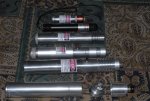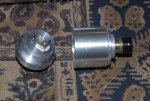JLSE
1
- Joined
- Dec 13, 2007
- Messages
- 3,580
- Points
- 0
So I decided to get into the C-Mount diodes, as im gearing up for some 532nm builds. Alignment is going to be critical and I wanted to get a feel for the setup. There isnt too much info out there, mainly pics, which I can gather a better understanding. I have seen C-Mount diodes up to 5000mW (5W), which is probably too much power for the pump medium I intend to use.
The diodes which im currently using are 1100mW @ 836nm originally meant for communication applications. The interesting thing with these is that there is no visible light whatsoever. 808nm give a nice faint red glow but are still visible to some degree. So while they may not have a pretty beam, they are super destructive and can only be seen with an IR cam or nightvision goggles.
My first test assembly was more or less a mock up to get in the swing. The only problem I see is the heat these little buggers generate At full output, your lucky if you get 2min's before it gets nice and hot. Im going to build another today with a monster heatsink, and possible active cooling.
At full output, your lucky if you get 2min's before it gets nice and hot. Im going to build another today with a monster heatsink, and possible active cooling.
The next challenge is going to be the power supply, I ran this one straight off a single lithium which is only rated for 880ma, so im going to have to find a circuit that can deliver 1600ma from two of these cells and not contribute to the heat that the diode produces.
In the video, its running at full tilt using 12vdc through an LM317 mounted on a big heatsink. Any suggestions for a suitable circuit would be great
While these are multimode, they seem to behave a little different than a 808nm 9mm package, in that I get a decent collimated beam from a standard Axiz acrylic lens :
Enough with the talk heres the pics and the vid. ;D
Enjoy.
[media]http://www.youtube.com/watch?v=dJWbnprQNYs[/media]








The diodes which im currently using are 1100mW @ 836nm originally meant for communication applications. The interesting thing with these is that there is no visible light whatsoever. 808nm give a nice faint red glow but are still visible to some degree. So while they may not have a pretty beam, they are super destructive and can only be seen with an IR cam or nightvision goggles.
My first test assembly was more or less a mock up to get in the swing. The only problem I see is the heat these little buggers generate
The next challenge is going to be the power supply, I ran this one straight off a single lithium which is only rated for 880ma, so im going to have to find a circuit that can deliver 1600ma from two of these cells and not contribute to the heat that the diode produces.
In the video, its running at full tilt using 12vdc through an LM317 mounted on a big heatsink. Any suggestions for a suitable circuit would be great
While these are multimode, they seem to behave a little different than a 808nm 9mm package, in that I get a decent collimated beam from a standard Axiz acrylic lens :
Enough with the talk heres the pics and the vid. ;D
Enjoy.
[media]http://www.youtube.com/watch?v=dJWbnprQNYs[/media]
























